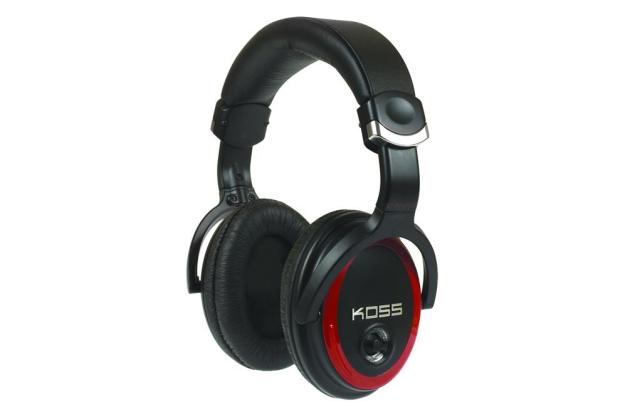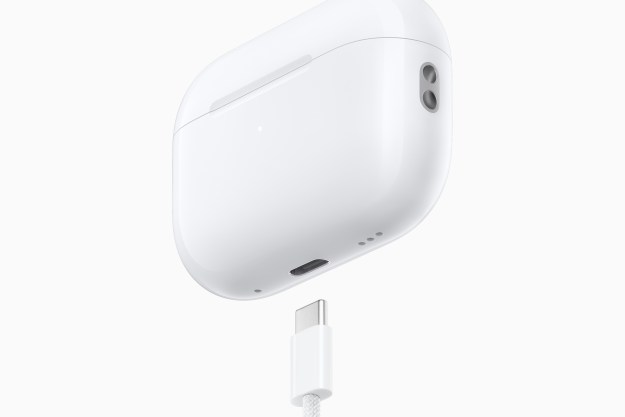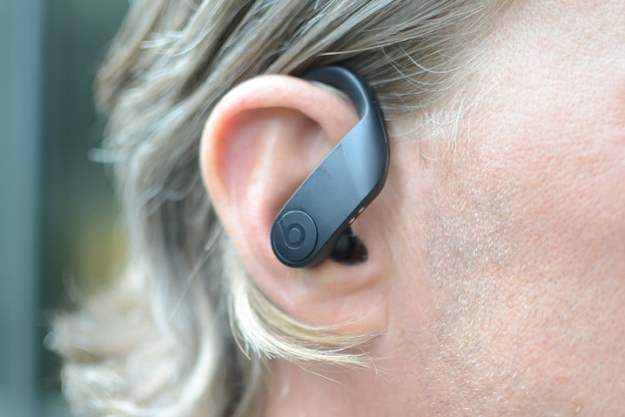
“The Striva Pros just aren’t very competitive with many of the other wireless headphones available today, especially at $450.”
- Durable build quality, comfortable fit
- Longer range than Bluetooth
- Online streaming music management
- Excellent assortment of accessories
- Cheaper competitors sound noticeably better
- Overall quality not commensurate with price
- Random signal drops
- Difficult setup
- Only average noise isolation
Koss claims its Striva Pro are “The world’s first true over-the-ear Wi-Fi headphones,” offering better wireless range, connection flexibility, and sound quality than Bluetooth-capable cans. But modern Bluetooth headphones like the recently reviewed Sennheiser MM 500-X have come a long way from their notoriously flaky predecessors, leaving the Striva Pro some pretty stiff competition. Is Wi-Fi really the way to go? We put the Striva Pro to the test to find out.
Out of the box
Some headphone makers have gotten hip to the fact that nothing sets up the listener’s anticipation and product expectations the way a great reveal can. Koss isn’t one of them.
The Striva Pro arrived in an almost plain, inconspicuous, brown cardboard box. If it wasn’t for the printed text on it, we could have easily mistaken it for one of the many generic shipping boxes around the office, ready to be recycled.
You could chalk it up as simple and understated, or even eco-friendly, but it’s not what you expect from headphones costing $450.

Things looked up once we peeked inside the box. Pulling out the headphones from their semi-rigid case, we got the impression that we had some well-made and durably-built headphones in our hands. Their smooth black finish and gloss red accents were tasteful appointments. Though the Striva Pros weren’t the most luxurious cans we’ve seen around $500, they didn’t feel cheap, either.
Besides the Striva Pro headphones, the package includes a Striva Cap (content access point) wireless transmitter, two different-sized mobile device attachment straps for the Cap, an AC wall power adapter, a semi-rigid carrying case, a mini USB-to-audio cable for corded listening, a shorter mini USB-to-USB headphone charging cable, a mini USB-to-audio cable for streaming via the Cap, a longer mini USB-to-USB, Cap setup cable, and a setup guide.
Features and design
The Koss Striva Pro adopt a circumaural (around the ear) closed-back design, which means they’re unlikely to offend anyone else’s aural sensibilities while you’re using them on a plane or during your public commute. A plush leatherette headband with good padding provides support up top, and the same leather-like material also wraps the ear-cup cushions. The ear cups are hinged on heavy-duty plastic bands that slide in and out of the headband for a wide range of adjustment. They also tilt and rotate to better fit your head, or to fold into the storage case.

These headphones provide three different listening options: traditional corded listening, wireless Internet radio streaming, and wireless transmission from any source’s stereo audio outputs — such as headphone outputs or analog line outs on A/V gear and TVs — with the Striva Cap adaptor. Koss claims its Wi-Fi transmission technology can broadcast up to 300 feet in optimal conditions, or nearly ten times greater than the 33-foot range of typical of Bluetooth headphones.
Except for volume, all of the various headphone controls are integrated into a single, multi-directional, multi-function button built into the right ear cup of the Striva Pro. A touch-sensitive “ridge” located next to the control button adjusts volume; slide your finger up the ridge for more volume, down for less.

You can setup Striva headphones online at My Koss; the site also functions as an Internet radio playlist and station management system for streaming music to straight to your Striva cans. As long as you have Wi-Fi access from access points registered with My Koss, you can turn on the Striva Pros and listen to streaming Internet radio without any additional hardware. Shoutcast radio streams can also be streamed by adding in their respective URLs.
Koss estimates the Striva Pro’s headphone battery should last for about 15 hours in Wi-Fi or 8 hours in Striva Cap mode; the Cap’s battery should last for about 3 hours in Wi-Fi or 2 hours in Cap mode.
Setup
The Striva Pro requires a Windows, Mac OS X or Linux computer with a spare USB port and the latest version of Java installed. You’ll also need an email address for validation setup and SSID info for the computer’s Wi-Fi access point or router. From there, the user must create an account at mykoss.com, register the headphones, and follow the online setup procedure.
After setting up the Striva Pro first with a temporary account and later with another one, we ran into our first snag: You cannot register the same headphones with more than one account. My Koss told us our headphones were already registered.

We had to call the Striva help line to associate our cans with our new, permanent account instead of the old one. Our agent was very helpful, but this might be something to keep in mind if you’re planning on sharing these headphones with someone else in the house: Unless you share the same musical tastes, they’ll need to have your account information and email address handy in order to set up their own music channels on your My Koss site. Once we had the proper My Koss account going, completing setup was a bit simpler. All that remained was adding the Striva Pros to our my Koss account, connecting the Striva Cap to our computer for registration and setup, and powering on our headphones to associate them with our account, Striva Cap, and Wi-Fi signal.
If that sounds like a lot work to get the Strivas up and running, that’s because it is: Setting up the Strivas was definitely more complicated than your average Bluetooth headphones. Usually, Bluetooth cans require little more than pressing a couple of buttons to pair them up with a device. Be prepared to do more work setting up the Striva Pros.
Audio Performance
We used a variety of components to test the Striva Pro, including: a Dell Latitude D810 laptop; an Apple iPhone 4; a Schiit Lyr headphone amplifier; a Marantz NR-1602 A/V receiver; and a Denon DCD-CX3 SACD, Samsung BD-C5500 and Oppo BDP-83 Blu-ray player. We also had several sets of headphones on hand for comparison, including the Sennheiser MM 500-X, Bowers and Wilkins P5, and Phonak Audeo PFE 122.
After 20 hours of break in, the Striva Pros had a fairly smooth tonal balance save for some thinness in the upper bass and lower mids. They had no other immediately obvious frequency-related peaks or dips, initially sounding fairly cohesive from the bottom to the top of their range. With a quick listen, the Striva Pro’s sonic personality seems to toe the line well, especially on less demanding music, such as chamber music and solo instruments.

Once we starting listening deeper however, their sonic anomalies became more consistent. Bass sounded fairly deep and well extended, but could tend towards a little lumpiness. An emphasis centered somewhere around the 80Hz to 100Hz region gave pitched instruments, like upright bass, cellos, and bass guitars, a “one-note” sort of quality. In other words, bass sounded as if it had an artificial boominess right in this region. Paul Chambers’ bass on Miles Davis’ Kind of Blue, for example, had a certain heft to it when he played notes in this range; but when the notes went a bit lower or higher, that weight went missing. This made the Striva Pro’s bass sound somewhat indistinct and lacking in overall clarity.
Listening to dense, well-detailed recordings like Jim Noir’s Tower of Love, it became more apparent that the Striva Pros were missing a noticeable amount of upper bass and lower midrange information. They just didn’t have the fullness, detail, or presence in this region that we’ve heard many times from other headphones. Consequently, they robbed music of some of its tonal and harmonic development, especially with sound like male vocals, guitars, and horns.
Our comparison headphones had much better separation between instruments and harmonized vocals. With the Sennheiser MM 500-X, for example, we could more easily follow the many different instruments on Tower of Love, or the individual choral voices on Stile Antico’s Music for Compline album.
But was Wi-Fi transmission to blame, or the headphone drivers? To find out, we went back and forth between the Striva Cap and the wired connection, playing the same files from the same source (an iPhone 4) over and over again. While the headphones did have a bit clearer bass and treble via the wired connection, they were awfully close both ways.

Even headphones costing less than half as much sonically outclassed the Striva Pro. The Phonak Audeo PFE 122, for example, possessed greater temporal precision — on multi-layered, beat-heavy tracks seemed to start and stop more in sync with each other. The Koss cans made music sound less rhythmically cohesive overall. Music with dense or poly-rhythmic lines was simply more difficult to follow with the Striva Pro.
We also tried listening to the Striva Pro wired up to our Schiit Lyr headphone amp to eliminate the iPhone 4 as the sonic culprit. Unfortunately we still got pretty much the same results. And once the Lyr amp came into play, all of the other headphones we had on hand sounded even better in comparison.
The Bowers and Wilkins P5, for example, had more of a sonically natural presentation than the Striva Pro, which sounded grainier and more distorted through the upper midrange and lower treble. With the Koss cans, things like the initial instrumental attacks and transient information sounded prematurely clipped, reducing the overall realism of the sound.
We did however appreciate the Striva Pro’s overall comfortable and secure fit. We listened for almost two hours while moving about doing some yard work, and we never experienced any sort of undue pressure or head fatigue. The Striva Pros always felt fairly light on our head, providing a good, well-cushioned seal without putting our head in a vise grip and getting hot or clammy.

The Striva Pros are only about average when it comes to noise isolation however. They did attenuate a smidgen of noise, but we could still hear most normal-level conversations and TV sounds coming through. Still, we don’t imagine Koss built these headphones with noise isolation as a priority, so for those looking for more robust noise reduction, we’d definitely recommend looking at other options instead.
Wireless performance
Though Koss specifies the Striva Pro’s usable wireless range as up to 300 feet in optimal conditions, we got about 100 feet line of sight while streaming from both Wi-Fi signal and our CAP-strapped iPhone 4. After that distance, the signal dropped completely.
After resolving some initial Wi-Fi issues with technical support, we used My Koss to add our favorite Shoutcast stations and create our custom playlists. After some listening this way for a while, the headphones repeatedly lost signal, then tried to get it back, but to no avail. We decided to ring up Koss tech support one more time, only this time we got their voicemail. Switching to Cap mode and power cycling the headphones got us a few solid minutes of our music, until the same signal drops came back. Leaving the headphones turned off for a bit seemed to do the trick, as we experienced only one more random drop out for the rest of our auditioning period.
Though most users who tested the Striva Pro found the direct streaming option novel for a few minutes, most quickly reverted to their smartphones for music listening. Direct Wi-Fi streaming and tons of Internet radio stations sound appealing in theory, but anecdotally, most folks preferred to choose what they listen to.
Conclusion
The Koss Striva Pro certainly have their good points: long usable range, compact Wi-Fi transmitter, and an overall comfortable design. The company’s knowledgeable and friendly customer service really deserves a medal, especially considering the amount of tech help we required.
Once performance quality is factored in however, things shape up quite differently. We could forgive minor quirks like lackluster packaging and occasional signal drop outs if they sounded really, really awesome. Sadly, they don’t. They were clearly bested by various other headphones we had on hand, including the lower-priced, Bluetooth-enabled Sennheiser MM 500-X. The Sennheisers were also easier to setup and use, more consistent in operation, and didn’t require a dongle for smartphone listening. Other wired headphones, such as the Bowers and Wilkins P5 and Phonak Audeo PFE 122s, also sound much better and cost noticeably less than the Striva Pro. In day-to-day use, we always ended up listening to our own music instead of the Internet stations, rendering direct Wi-Fi streaming and My Koss moot points for us.
Add it all up, and the Striva Pros just aren’t very competitive with many of the other wireless headphones available today, especially at $450. We only recommend them for that niche listener who really needs Wi-Fi range and Internet radio beamed directly to his ears.
Highs
- Durable build quality, comfortable fit
- Longer range than Bluetooth
- Online streaming music management
- Excellent assortment of accessories
Lows
- Cheaper competitors sound noticeably better
- Overall quality not commensurate with price
- Random signal drops
- Difficult setup
- Only average noise isolation
Editors' Recommendations
- Best Beats headphone deals: Studio Pro, Studio Buds, Powerbeats
- Beyerdynamic’s DT 770 Pro X offers premium features for less
- JBL upgrades its 2024 wireless headphones with massive battery life
- Apple lets AirPods Pro owners upgrade to USB-C
- Soundcore’s first open-ear earbuds come with an optional neckband


